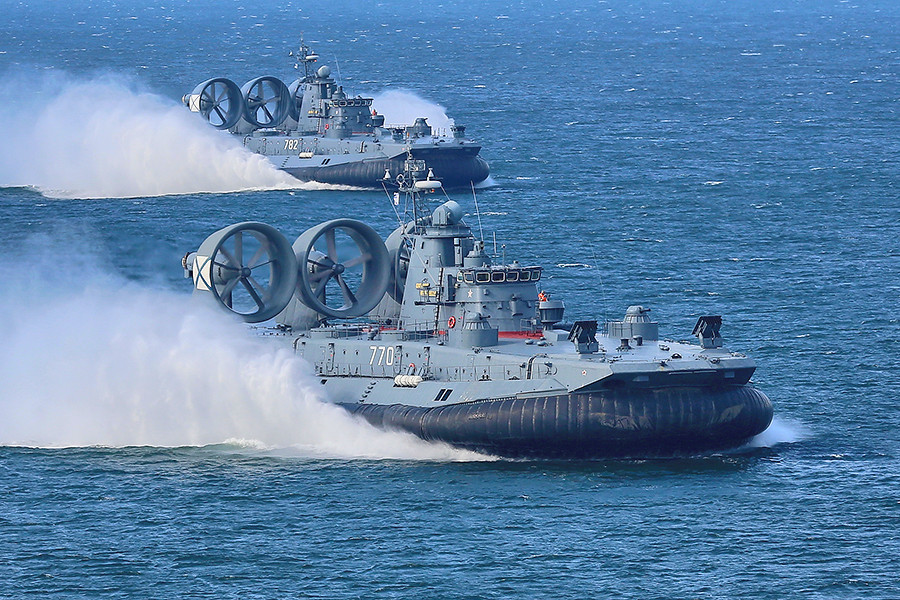
Mordovia and Yevgeniy Kocheshkov landing in
Kaliningrad Oblast.
The Russian Navy will get an additional 16 warships,
according to the country’s United Shipbuilding Corporation that has been
contracted by the defence department to deliver the vessels – although they
will not all be new.
Defence Minister Sergei Shoigu said that the Navy was to get
seven new combat ships, including four submarines and seven repaired ones.
Among the repair projects, at the Yantar Shipyard on the Baltic coast, the
world’s largest air-cushion amphibious assault ship Mordovia. The Project 12322
`Zubr’ air-cushion small amphibious assault ship Mordovia entered service with
the Baltic Fleet in October 1991. The ship’s role is to provide heavy sealift
support to amphibious operations.
The warship can also transport and deploy sea mines. The
air-cushion design allows the ship to move over the ground. The warship can
transport three tanks or ten armoured personnel carriers or eight infantry fighting
vehicles. But the huge radar signature
of the Zubr makes them unsuitable for covert operations and they require significant
logistical support in fuel and maintenance.
The Zubr class (Project 1232.2, NATO reporting name
“Pomornik”) is a class of air-cushioned landing craft (LCAC). This class of
military hovercraft is, as of 2012, the world’s largest, with a standard full
load displacement of 555 tons. The hovercraft is designed to sealift amphibious
assault units (such as marines and tanks) from equipped/non-equipped vessels to
non-equipped shores, as well as transport and plant naval mines.
There are ten Zubr-class hovercraft in service. There are
two vessels in the Russian Navy and four with the Hellenic Navy. In 2009, China
placed an order for four vessels from Ukraine [order transferred to Russia now]
as part of a deal worth 315 million USD. Two updated versions of the vessels
were built by Crimea’s Feodosia Shipbuilding Company, followed by two advanced
models of the surface warship.
The purchase of HS Cephalonia (L 180) for the Hellenic Navy
marked the first time a Soviet-designed naval craft had been built for a NATO
member.
In June 2017, Russia announced it was restarting production
of the Zubr-class craft. Representatives from the Russian shipbuilding industry
soon after responded by stating production could not possibly resume in 2018
and would only be possible by 2019–2021, refuting the government position.
Representatives cited the lack of availability of and inability to mass-produce
components, notably gas turbine engines and reduction gears as the main
obstacles.
NPO Saturn (ODK GT) and Turboros developed marine gas
turbine M70FRU (D090), FR RU, M70FRU2 (DP/DM71) along M90FR, M75RU, E70RD8 and
Elektrosila, AO Zvezda, Metallist, Samara and others developed reductors and
gears. Fan and Turboprop provided by NK Kuznetsov, Aerosila, among others
(perhaps some like Aviadvigatel, Salut, AMNTK, UMPO, KMPO, having high and long
experience and production).
The Zubr-class landing craft has a cargo area of 400 square
metres (4,300 sq ft) and a fuel capacity of 56 tons. It can carry three main
battle tanks (up to 150 tonnes), or ten armoured vehicles with 140 troops (up
to 131 tonnes), or 8 armoured personnel carriers of total mass up to 115
tonnes, or 8 amphibious tanks or up to 500 troops (with 360 troops in the cargo
compartment).
At full displacement the ship is capable of negotiating up
to 5-degree gradients on non-equipped shores and 1.6 m (5 ft 3 in)-high
vertical walls. The Zubr class remains seaworthy in conditions up to Sea State
4. The vessel has a cruising speed of 30–40 knots (56–74 km/h; 35–46 mph).